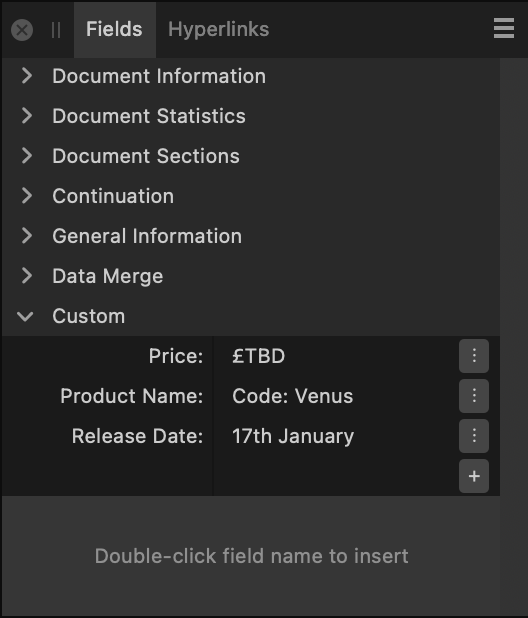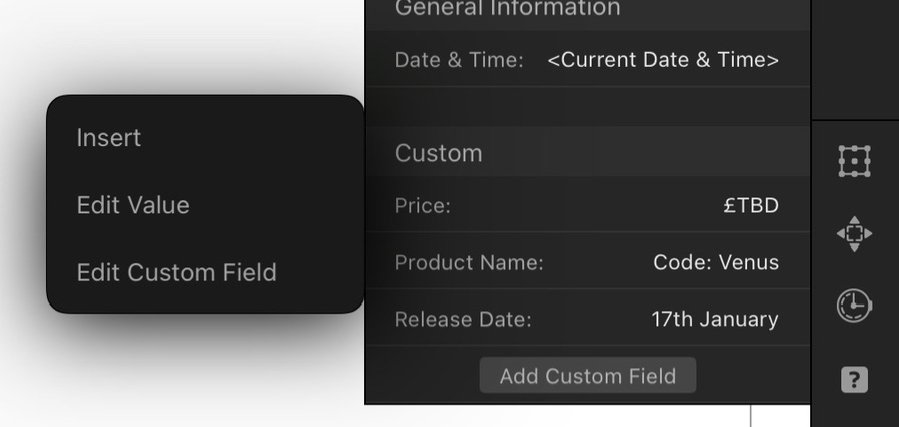Search the Community
Showing results for tags 'rmap-277'.
-
Apps: Publisher Platforms: All Affinity Publisher now has the ability to define custom text variables as fields. This allows you to add new fields and assign whatever value to them you wish. Within the Fields panel, you will now see a new section for "Custom". Within that there is a + button where you can add your own fields. For example, in this screenshot three custom fields have been created: <product name>, <price> and <release date>. I can now add these fields into my document, so any references to the price, name and date are drawn from the field values. In this example this means when the price and product name is confirmed I can just update the field value and every instance of that is updated throughout my document. For iPad you can find custom fields at the bottom of the fields panel. You can add fields using the "Add custom field button". On iPad to edit the field you need to long press on it which gives the options in the flyout menu.
-
So, beta 2.2 is here, and we can see that some very important features have been added, and with remarkable creativity. Development is proceeding slowly but steadily. Since new features are announced as possible during the next months, it is hard to say what we will have in Publisher before the end of the year. Just to recap, however, I'll write down what I still miss for my own needs. - Multipage tables. I work with tabular-heavy data, so I can't really use the current feature. - Object styles. I have to adapt my content to different styles. The current situation is that I should re-apply the object presets to each object in a publication. With their number easily going over 1,000, this is hardly feasible. I need object styles. - Text variables. Much of my work is referred to products available in different variants. The name of the product and of some of its features and controls can change. Without text variables, I have to use search and replace, with the imaginable risk of changing what shouldn't be changed. - Conditional text. Product variants also means an abundance of alternative text and images. - IDML export. This is a show-stopper for two reasons: (1) interfacing with assisted translation software, and (2) compatibility with my colleagues working in InDesign. While some of them may be wanting to switch to Affinity, this is not always possible for a series of reasons (company decisions, unwillingness to change, prestige associated with the Adobe name, lack of support of RTL languages, incomplete support of CJKV languages). And then, back to (1): they wouldn't be able to use their CAT tools. - DOCX export. I see this file format as the perfect interface for ePub and Web. The tools I use for this type of work require DOCX/RTF files. Copy & Paste from Publisher may work for text, but the lack of images would make rebuilding the project quite hard. - ICML import. Not a real show-stopper, but a cause of slowdown. It is the file format generated by Pandoc. I described somewhere else in this forum how to go from ICML to IDML, but it is not exactly a quick operation. Since ICML is just a subset of IDML, it would be very easy for Serif to support it. It's just a matter of adding the file into a <Story> element of a IDML template. - RTL support. Admittedly, I don't have much control on the work of the distributors using RTL languages. And I know that most of them prefer to work in Word or LibreOffice. But I must consider this as a limitation. And it happens, to me, to have to produce short multilingual documents including RTL languages. - Better CJKV support? I have still to understand if horizontal text is managed correctly or not. There is an inexplicable reluctance in talking extensively about this issue from our Chinese or Japanese fellows here in the forum, that I can't still get if it can be used or not. And I can't yet, for various reasons, get information from my colleagues (who don't use the Affinity suite, or only informally admit to have it installed in their secret computer). So, another year of InDesign CC subscription and file lock-in is to be expected Paolo
-
Wish: support for Text Variables. Very handy e.g. to define revision numbers and other stuff and inject document metadata (date printed, modified, created, etc.) at appropriate places. Makes the document more evolvable (maintainable). Wish++: share Tet Variables across documents (Designer, Publisher, Photo).
-
Hi, I'm in the dark hour of having to plan the forthcoming work for my team. Some of us were confident to be able to switch from InDesign to Publisher during this year, but at the moment this looks unlikely. While Serif doesn't reveal the future features, let's see if they can at least say what will not, for sure, be implemented from now on. At least, we will know if a fundamental feature will never be implemented, and think to possible solutions (or lack of them). This must be clear: we expect that Publisher will also include things that InDesign has stopped developing, after switching to subscription. But, at the moment, feature parity is an absolute priority. What we need to replace InDesign is the following. - Export to IDML, and continued support for IDML import. This is needed both (a) to maintain compatibility with the team members wanting to remain with the Adobe suite, and (b) to interface with translation support software. Members in the CJK and Middle East countries can't, at the moment, even think of switching to Publisher. This might look a niche problem to most users, but it is a major one for some. While the Affinity Suite is labeled as a "design" suite, the sad reality is that from the time Publisher was released it also had to deal with text… - Export to DOCX. This is needed for reusing the text content for advertising, videos, and even translators preferring to work in Word or LibreOffice. And it is the needed link for ePub and HTML, being the accepted file format for programs that can help generating these outputs. For example: we heard that Publisher will export in fixed ePub sometimes, but we need reflowable. And there are already tools that can help us with it. - Long tables, extending over multiple pages. We have tables extending over many pages. There are no viable workarounds that I can think of, apart for – using InDesign… - Object Styles. We have to adapt our visual styles to the different products and output targets. One of the most common situations is the difference between printed materials (with fewer visual effects, less dark areas) and onscreen ones (richer in visual effects). - Text Variables. These are really huge time savers sometimes. Text Variables make adapting a manual to a different product a matter of hours, instead of days. - Conditional Text. This is another of the things making adapting a book to a different context something quick and error-free. Are these features for sure excluded from development, in the next months or so, or even excluded forever? Paolo






